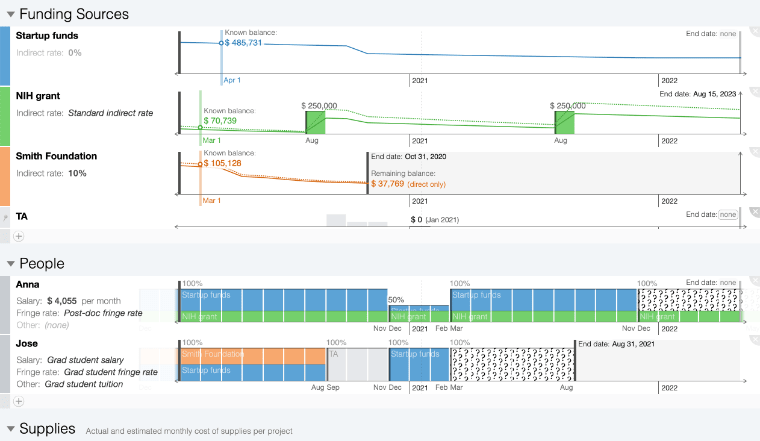


Most grant reporting tools track your funding sources separately, making it difficult to see the whole picture. Spendlab fills that gap by providing a labs-eye view for tracking and exploring viable funding plans.
It started in a single lab at the University of Washington and is now used by PIs and administrators across the world to plan, manage, and communicate grant spending.
Try it for free
3-month free trial so you can see if it works for you. Yearly pricing is set by the community. We recommend watching the 3-minute intro video and checking out our other resources.
See all your grants and expenses together instead of juggling spreadsheets.
Click and drag to quickly add expenses and allocate them to grants.
Handle multiple funding sources, recurring payments, indirect/overhead costs, raises and fringe benefits, and much more.
Avoid overspending and underspending. Plan for funding gaps and grant expirations.
We're honored to collaborate with top research labs whose feedback has deeply shaped the Spendlab software. Host organizations include:
University of Washington • MIT • Yale • Harvard • Tufts • Johns Hopkins • Baylor College of Medicine • Duke • University of Montréal • Simon Fraser University • LMU Munich • University of Michigan • University of California • University of Texas • University of Chicago
Spendlab is a for-purpose organization — more flexible than a strict non-profit, and more community-centered than a traditional business. Our purpose is to help labs make the best use of grant resources.
The idea for Spendlab arose when Robin's friend — a professor — described how much time she spent paging through spreadsheets and documents just to answer simple questions about her lab’s budget. Together, we designed Spendlab with the goal of minimizing the amount of time it takes to input data, modify spending plans, and keep track of what's going on in the lab.
 Robin Stewart (Founder)
Robin Stewart (Founder)Robin is a software developer based in the Seattle area. Previously he designed data visualization tools at Tableau Software and studied human-computer interaction at MIT. His research combines direct manipulation and data visualization techniques to make numbers easier to use.
 Lisa Stachura (Associate)
Lisa Stachura (Associate)Lisa is passionate about helping people get the most out of the products they use. She leads training and customer support at Spendlab and has many years of experience in a variety of customer-facing roles. She is a graduate of Michigan State University.
 Alan Sun (Intern)
Alan Sun (Intern)Alan is a Computer Science and Statistics major at Williams College. He joined Spendlab because of his interests in software development as well as UI/UX design, and later hopes to find a career working in the tech space.
 Lily Levin (Intern)
Lily Levin (Intern)Lily is an Economics and Comparative Literature major at Williams College. She joined Spendlab to further explore her interests in problem-solving and market research.
 Anh Nguyen (Intern)
Anh Nguyen (Intern)Anh is a computer science and mathematics major at Williams College. She is interested in software development and hopes to build a career in tech.
“I literally don't know how I would run my lab without Spendlab. I refer to it daily.”
-Assistant Professor, University of Washington
Spendlab's operational model is designed to ensure that the software will stay available over the long term. Yearly licenses support ongoing development, while low operating costs and no venture capital greatly reduce financial pressure.
Spendlab includes a 3-month free trial to give you plenty of time to try it out. After that, you will need a yearly license to save new versions of your budget files.
The most common options are listed below. If you have feedback, would like to request free or alternate pricing for special circumstances, or have any other requirements, please just let us know.
Use Spendlab with colleagues. This helps the software become a standard tool in your department.
Share your success stories. How has Spendlab impacted your budget planning or benefited your lab or department?
In any case, please join the email list below to let us know you're interested and to get notified when we add new features. (Average two emails per year, and of course you can unsubscribe at any time.)
Get notified of important updates by joining our rarely-invoked mailing list. (Average two emails per year.)
(Unsubscribe at any time. We will never sell or share your email address or any other personal information.)
Watch our getting started videos below or check out the complete reference guide for all the details. You can also find out what's new.
Your budget files never travel over the internet, even though the Spendlab software operates in a web browser. All calculations are done on your own computer using modern client-side web technology.
When you click the “Save” button, your budget file is downloaded directly to your computer as a .slb file ("spend lab budget") — so you can store it however you’d like or share it with colleagues.
Spendlab also tries to autosave your most recent budget file in your web browser's local storage as a backup. You can disable this feature by browsing in "private" or "incognito" mode.
The software allows you to quickly experiment with strategies for spending your grant money most effectively, so it's a type of "laboratory" for making spending decisions — a "spend lab".
It's also commonly used by scientific lab groups for their budget planning, so the name can be seen as describing the software as "spend" planning for "labs".
Spendlab is simpler to use than it is to describe. The best way to get a sense of it is to just use it.
Questions and feedback are welcome! Email Lisa at .
We're occasionally on Twitter at @SpendLabOrg.


